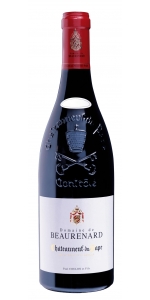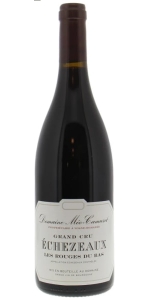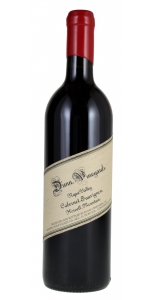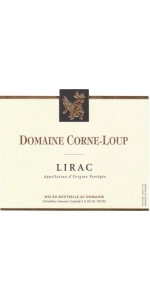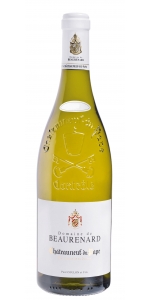Domaine du Colombier Hermitage Rouge 2017
6 bottles with free shipping for: $570.00
12 bottles with free shipping for: $1,080.00
| BUY MORE! SAVE MORE! | ||||||||||||||||||||
|
Domaine du Colombier Hermitage Rouge is made from 100 percent Syrah.
Perfect with beef ribs, grilled meats and cheese.
Manually harvested with destemmed grapes and fermented for about 2 to 3 weeks in temperature controlled vats, with an ageing period of 12 months, 65% in oak barrels and 35% in concrete tanks.
Review:
Brought up in 30% new demi-muids, with the balance in used barrels, the 2017 Hermitage is beautifully pure and layered, with smoking good notes of crème de cassis, white flowers, crushed rocks, and violets. Deep, full-bodied, and concentrated on the palate, it has plenty of tannins and is going to need 5-7 years of bottle age. This is a sensational Hermitage from Colombier that will drink well for 25+ years.
These wines are made by the talented Florent Viale and shine for their purity as well as character. While the winemaking here is traditional, with the wines destemmed and brought up mostly in used demi-muids, the purity of fruit can give the impression that wines are more modern styled than they are. They will all benefit from short-term cellaring.
-Jeb Dunnuck 96+ Points
The Domaine de Colombier Estate
Domaine du Colombier is located in the Northern Rhone Valley, in the left bank of the Rhône River. The estate has been part of the family since the First World War. The owners gradually moved from a sharecroppers status to that of owners. Florent Viale joined his father in 1990 and decided to bottle part of their production in 1991. Now they sell 80% in bottle, 20% in bulk.
The Domaine de Colombier Vineyard
This 12 hectare (30 acres) Domaine spreads over the two communes of Tain l'Hermitage and Mercurol and is comprised of:
1.6 hectares (4 acres) of Hermitage
1.2 hectares (3 acres) of white Crozes-Hermitage
9.2 hectares (23 acres) of red Crozes-Hermitage.
Total: 12 hectares (30 acres)
The vineyard, located on stony hillside, is planted with old vines (50-55 years of age): Syrah for the red and Marsanne for the white. The grapes are harvested by hand.
Alain Jaume Domaine du Clos de Sixte Lirac is made from 50% Grenache, 35% Syrah, 15% Mourvedre
An intense red garnet color. On the nose, aromas of red and black ripe fruit (kirsch and wild blackberry). The mouth is full, with aromas of blackcurrant liqueur and spice. Tannins are both harmonious and elegant thanks to the fleshiness of the wine. Hints of licorice and vanilla on the finish, which gives the wine length and complexity.
Soil type LIRAC vineyard is facing Chateauneuf du Pape, opposite side of the Rhône river. As showed by the picture and following geologist George Truc, soils are almost similar in both side. They are marked by the violence wrought by the Rhone river. It consists of a layer of marine molasses of the Miocene period covered by alpine alluvium. The presence of a great number of rounded stones known as "galets" in the earth is evidence of the time when the Rhone, then a torrent, tore fragments of rock from the Alps and deposited them on the plain. LIRAC is one of the up-coming best area from the southern Rhône valley, as it delivers outstanding wines. Winemaking & ageing Traditional wine-making in stainless still vats. Hand sorted bunches, crushed and destemmed grapes. Fermentation temperature : 30°C. 18 days of vatting with pigeages.
Domaine de Beaurenard Chateauneuf-du-Pape is made from 65% Grenache, 15% Syrah, 10% Mourvèdre.
Domaine de Beaurenard’s flagship wine is a quintessential blend, reflecting all the diversity of the terroir and the perfect synergy that exists between the soils and the grapes. It offers a supple and refined texture associated with a delicate aromatic palette that is the result of a constant quest for freshness.
Review:
Checking in as a blend of 65% Grenache, 15% Syrah, 10% Mourvèdre, and the rest a handful of varieties, the 2019 Châteauneuf Du Pape was brought up in a mix of foudre and older barrels. This deep ruby/purple-hued effort has a pure, vibrant, incredibly seamless, medium to full-bodied style that carries classic notes of black raspberry and black cherry fruits as well as peppery herbs, violets, spring flowers, and sous bois. This straight-up gorgeous, seamless, ultra-fine 2019 should be snatched up by readers. It has a rare mix of elegance, purity, and power, and it’s going to have two decades of prime drinking.
-Jeb Dunnuck 95 Points
Échezeaux is loyal to its appellation through the finesse of its attack on the palate and its overall balance. But it's also a wine with pronounced acidity, which gives it freshness and structure and bestows upon it a sometimes austere finish.
This signature wine contains only fruit farmed on Howell Mountain. The wine comes in a distinctive bottle that is hand dipped in red wax. 100% Cabernet Sauvignon. aged 32 months in 100% new French oak.
Vinous 97 Points
Corne Loup Lirac Rouge is made from 50% Grenache, 40% Syrah and 10% Mourvedre
Dry - less than 4 grams/liter
Color: dark red ruby.
Aromas: red berries, truffles and spices.
Flavors: complex and rich. It shows red and black fruits, with an herbal spice type of aromas coming from the surrounding vegetation (Garrigue).
The average age of the vines is 40 years. (The oldest vines are 80 years old).
The soil is mainly sandy marl and small pebble stones.
Pairs with lamb, duck, turkey, red meat, game and cheese.
Domaine de Beaurenard Chateauneuf-du-Pape Blanc is made from Clairette blanche & Rose, Grenache Blanc & Gris, Bourboulenc, Roussanne, Picpoul and Picardan.
Gold bright green color. Expressive nose with pear and stone fruits aromas (peach, apricot) with jasmine and roasted almonds notes. The mouth is smooth and fleshy like stone fruit we can smell, with a long a nice finish.
Review:
Bright golden yellow, silver reflections. Delicate herbal spices, a hint of chamomile and mandarin zest, pears and blossom honey are underneath. Juicy, elegant, white peach, delicate honeydew melon, mineral and harmonious, fine fruit sweetness, good ripening potential.
-Falstaff 92 Points
- back
Double Diamond by Schrader Oakville Cabernet Sauvignon is made from 100 percent Cabernet Sauvignon.
The 2021 Cabernet Sauvignon stands to outshine the award-winning 2019 vintage with even deeper concentration and complexity. On the nose, the wine leaps from the glass with ripe blackberry, cassis, black cherry, and red plum, with a lovely herbaceous undertone. The palate expresses juicy red and black fruits with hints of black tea, damp earth, vanilla bean, lavender, and just a touch of flint. With fine-grained tannins and mouthwatering acidity that lingers through the long finish, this wine is ready to drink upon release but will cellar well for years to come.
Double Diamond is sourced exclusively from a complement of prime vineyard estates. Sourced from the same famed vineyards as its beloved inspiration Schrader Cellars in Napa Valley’s world-renowned Oakville AVA, including our To Kalon Vineyard.
Review:
The 2021 Cabernet Sauvignon is cut from the same cloth, with plenty of richness and depth, yet it stays slightly more focused and tight on the palate, with medium to full-bodied richness as well as beautiful darker currant, cassis, darker chocolate, graphite, and hints of flowers. It's concentrated and has beautiful mid-palate density, ripe yet building tannins, and a great finish. It's another undeniably delicious, hard-to-resist Cabernet Sauvignon from the talents of winemaker Thomas Rivers Brown. Give bottles a decant if drinking any time soon and enjoy over the coming 10-12+ years.
-Jeb Dunnuck 94 Points
Nicolas-Jay 'l'Ensemble' Pinot Noir Willamette Valley is made from 100 percent Pinot Noir.
Winemaker Tasting Notes | A bright, magenta color with pinkish red edges shows intensity, youthfulness and concentration. Aroma sequences immediately leap from the glass with freshness and vigor. There are red berries, freshly cut straw, rhubarb and elegantly perfumed red flowers. A blood orange zest intermixes with Herbes de Provence, cranberries and tight-grained French barrique. The structure of the wine is medium + at first, but as the wine unfolds in the mid-palate it begins to tighten and constrict. Acid levels are earnest in this wine, but there is a broad density that seems to take a combative stance to its brightness as the finish expands into chalky minerality, tangerine spice and an underlayment of crushed river rock. It's silky, pretty and elegant, but with a grit and willpower that suggests an exquisite vintage made by an experience and sensitive winemaking approach.
Vintage | The beautiful 2021 vintage began with a warm dry winter followed by a wet and cool late Spring. Despite rain during bloom, yields were high and the vines soaked up the nourishing moisture early in the season. June also brought a heat dome with temperatures breaking 115 degrees in the Willamette Valley. Luckily, this unprecedented heat came at a time before the grapes were susceptible to damage and the growing season continued warm but without issue. A cooler August was a sigh of relief as we neared harvest. Grape ripening slowed down and the very healthy and abundant fruit began showing signs of ripeness in early September. We began picking on September 4th with 2 separate chardonnay vineyards and finished on September 27th with our latest and highest elevation chardonnay site – Spirit Hill. Harvest was beautiful and dry with only one small rain event toward the end, ideal for a successful vintage. The fruit was pristine and yields comfortable, leading to moderate alcohol levels and bright acidity. Our first vintage made entirely here at the Nicolas-Jay estate, the wines are showing purity of fruit, beautiful texture and tension and are sure to continue to evolve for years in bottle.
Review:
A jeweled ruby hue, the 2021 Pinot Noir L'Ensemble needs a little time to open in the glass before revealing aromas of fresh pine, ripe cherry liqueur, and toasted spice. Supple and medium to full-bodied, with ripe tannins, it delivers elegant freshness and wonderful purity through its long, mouthwatering, seamless finish. Drink 2025-2037.
-Jeb Dunnuck 95 Points



